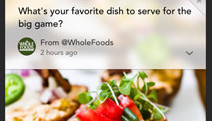How do we practice storytelling on social mediums where consumer behavior is at hyper speed? We respect the nuances of each social platform. We all know that content is king; but there is a new queen in town, and it’s called ‘context’.
We hear a lot about creative social strategy today, but not so much in this region. The biggest mistake brands are making in social strategy right now is looking at social media as a series of distribution channels. Companies are doing something, somewhere, and then using tweets or Facebook to drive traffic towards it.
We are going through a massive cultural shift with regards to how we consume content; everything is fast. We are living on micro-moments with an unlimited amount of outlets feeding us content. Time and attention have become our biggest commodities. As marketers, we need to adapt to this reality. If we don’t, we are not doing our job correctly.
Each social platform is different with its’ own unique features. This is why you get different reactions and behaviors to what you communicate based on where you communicate it . Pinterest, for example, is a medium most likely to inspire you through great imagery. Instagram gives you real life instant images and a look into someone’s life on a very personal community. We need to understand and respect the psychology behind why people use these mediums to communicate. Facebook, Twitter, Vine and even Tumblr are all fundamentally different.
Examples of successful visual social strategy: Dubai Shopping Festival 2014 event highlights Facebook cover banner (left), WholeFoods on Jelly in the USA (right)As an agency, we hear: “great. we have a stunning visual, lets’ publish it everywhere” or, “we have 5,000 Likes on Facebook and 4,000 followers, let’s post it”, all the time. This is where brands go wrong. Gary Vaynerchuk, author of Jab Jab, Right Hook says it brilliantly : “Create visuals mapped out to the psychology of that social platform, not to how many users you have”. Marketers need to focus on why consumers are there. Visual voices need to be created for each platform.
90 percent of information transmitted to the brain is visual, and Facebook posts attract 53 percent more likes then copy or link posts only. Thinking visually is in our nature; visual social strategy needs to become part of business plans.
Create emotional attention. This is what people want. Give them something funny, heart-warming. Dhow them that your brand is human. People spend time at certain places because they love the content they provide, like funny Gifs on Tumblr, or endless pins of how-to guides, or recipes on Pinterest. Give people value. You don’t need a business objective for every piece of content. Be ready to respond and engage. Don’t assign social media to sell your products, look at your overall business objectives and see where social media best fits and figure out what value you can bring to your consumers. Then and only then, sell your products.
Follow Alexandra Maia on Twitter on @alexandramaia_


 Back
Back 










